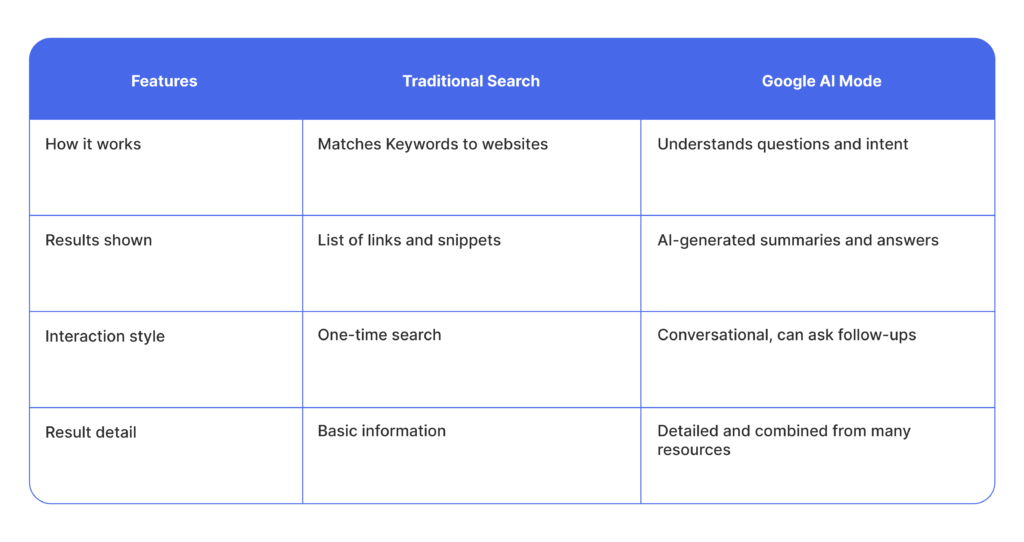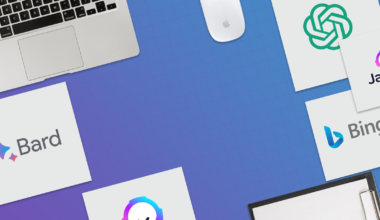Summary:
Google AI Mode is reshaping the way we search—and how websites get found. Launched on May 20, 2025, this major update has rolled out to U.S. users, bringing a dramatic shift in how Google delivers results. With AI deeply integrated into Google Search, everything from search rankings to content visibility is evolving fast. This isn’t just another algorithm update; it’s a fundamental shift in how users receive information.
For SEOs, marketers, and content creators, understanding Google AI Mode and tools like the Search Generative Experience (SGE) is no longer optional. In this blog, we’ll break down what’s changing, why it matters, and how to future-proof your SEO strategy in an AI-driven search landscape.
What is Google AI Mode?
Google AI Mode is a new way of searching that uses artificial intelligence (AI) to help you find answers faster and easier. Instead of just showing a list of links like a regular search, Google AI Mode understands what you’re really asking and gives you clear, easy-to-read answers right away.
This new search style is called the Search Generative Experience (SGE). It means Google’s AI can read information from different websites and give you a short, helpful summary, so you don’t have to check every site yourself.
Key Differences Between Google AI Mode and Traditional Search

Google AI Mode changes the way we search by making it smarter and more helpful. It’s designed to give you the right answer quickly, without making you click through lots of websites.
Key Features of Google AI Mode
Google AI Mode has several powerful features that make searching easier, faster, and more useful. Here are some of the main features that set it apart from traditional search:

1. AI-Generated Answers
Instead of just showing a list of websites, Google AI Mode gives you a full answer written by AI. It gathers the most important details from different sources and presents everything in one place.
2. Conversational Search
You can ask follow-up questions without starting over. The AI understands what you’re asking and keeps the conversation going, just like talking to a real person.
3. Summarized Results
The AI provides a quick summary of the top results. This saves time because you don’t have to read through every link to find what you need.
4. Context Awareness
Google AI Mode understands the meaning behind your search–not just the words you type. It looks at the full context to give more accurate and relevant results.
5. Visual and Rich Content
In some cases, you’ll see images, charts, or other visuals alongside the AI response, making the information more interactive and easier to understand.
These features make Google AI Mode a smarter way to search, helping users get better results with less effort.
How Google AI Mode Impacts Search Results
Google AI Mode is changing the way search results appear and how users interact with them. While it helps users find answers faster, it also brings some major changes for website owners, SEO professionals, and digital marketers. Here’s how it affects search results:

1. Visibility of Organic Listings
With AI-generated answers now featured at the top of search results, traditional organic listings are being pushed lower. As a result, websites may receive fewer clicks, even if they rank well. Users often find the information they need directly from the AI summary, bypassing the need to visit any website.
2. Changes to SERP Layout
The search engine results page (SERP) looks different from Google AI Mode. The AI answer box takes up more space and appears before ads and organic links. Sometimes, rich media like images or product cards are also included, which can affect how much attention other links receive.
3. Reduced Tracking in Analytics Platforms
Because users may not click through to websites as often, tools like Google Analytics might show less traffic from searches. This can make it harder for website owners to measure how well their content is performing, even if it’s being used in AI summaries.
These changes mean businesses and marketers need to adjust their SEO strategies to stay visible and relevant in this new AI-powered search environment.
SEO Challenges in the Era of AI Search
As AI becomes a bigger part of how Google delivers search results, SEO experts and content creators are facing new challenges. While AI-powered search can improve user experience, it also creates problems for websites trying to attract and measure traffic. Here are some of the main concerns:
1. Loss of Traffic Attribution
With AI summaries answering questions directly on the search page, fewer users are clicking through to websites. This makes it harder for site owners to see where their traffic is coming from or how their content is performing, even if it’s being used.
2. Content Usage Without Referral
Google AI Mode pulls information from websites to build its answers, but it doesn’t always link back clearly. This means your content might be used in search results without driving any visits to your site, reducing the value of creating high-quality content.
3. Publisher and Expert Concerns
Many publishers, bloggers, and industry experts are worried that their work is being shown in AI answers without credit or traffic. This raises questions about content ownership, fair use, and how creators will be rewarded in the future.
In this new era of AI-driven search, SEO isn’t just about ranking anymore — it’s about making sure your content stays visible, credited, and valuable.
Adapting Your SEO Strategy for AI Mode
As Google’s search evolves with AI integration, traditional SEO approaches must also transform. Below are three essential strategies to help you adapt your SEO for AI-powered search success.
1. Content Optimization Tips for Google AI Mode
Google’s AI mode changes how your content is seen in search. Instead of just ranking pages, AI generates answers by pulling trusted and relevant information. To stay visible, your content needs to be easy for AI to read and understand.
Use clear headings, short paragraphs, bullet points, and FAQs. Focus on answering user questions directly. Avoid keyword stuffing—instead, use natural language and related terms that help AI know what your content is about.
Always update your content to stay relevant. Add expert insights, statistics, and clear structure so Google knows your page is valuable.
Quick tips:
- Break content into sections with headers
- Use simple, clear language
- Add helpful visuals, lists, or FAQs
2. From Rankings to Value Metrics
In AI-powered search, getting clicks isn’t enough—Google looks at what happens after the click. Are users staying on your page? Are they getting value from your content? These new signals matter more than just being on page one.
Track how users interact with your content. Time on the page, scroll depth, and bounce rate show Google that your content is useful. If your article gets quoted in AI summaries, that’s also a big win.
Think beyond keywords. Aim to solve problems, not just attract visitors.
Key metrics to focus on:
- Time on page and scroll depth
- Zero-click search visibility (AI snippets)
- User actions: shares, saves, or sign-ups
3. Use Structured Data and EEAT to Build Trust
Google’s AI depends on clear, trustworthy sources. Help it understand your content by using structured data ( like schema markup ) to label your articles, FAQs, products, and reviews.
EEAT—Experience, Expertise, Authoritativeness, and Trustworthiness—is also critical. Make sure your content shows who wrote it, why they’re credible, and where the information comes from.
Showcase your expertise and use real-life examples or first-hand knowledge. This builds trust and helps your content appear in AI-generated answers.
To improve trust:
- Add author bios and credentials
- Use schema markup for articles and FAQs
- Link to reliable, up-to-date sources
Publisher Concerns and Implications
As AI-driven search features become more prominent, many publishers are raising important concerns about how their content is being used–and what it means for the future of digital publishing.
- Content usage without proper visibility
With the rise of Google’s AI-powered search, publishers are finding that their content is being used to generate answers without driving traffic back to their websites. This means users get the information directly in the AI summary and never visit the source, reducing visibility, clicks, and potential revenue for original creators. - Limited options for publishers to block their content
Unlike traditional search indexing, where publishers had more control, current AI features offer very limited options for publishers to block their content. Even if publishers don’t agree, their content can still be used in AI-generated responses, leaving them without a clear way to protect their work or manage how it appears in search results. - Expert opinions from industry leaders
Many experts and media professionals are worried about the long-term effects. They believe this change could hurt content ownership and long-term success, especially for smaller publishers and independent creators. Industry leaders are asking for clearer rules, fair payment, and responsible use of AI-generated content.
The Future of SEO in an AI-Dominated Search Landscape
- Predictions and long-term implications
AI will transform SEO by prioritizing user intent, content quality, and context over traditional keyword-based tactics. Search results will become more personalized and interactive, blending text, voice, and visual elements. SEO strategies will need to evolve to meet these changing user behaviors and AI capabilities. - How to stay ahead of algorithmic shifts
To stay ahead, focus on creating high-quality content that works well in different formats like text, voice, and video. Use AI tools to track trends and understand what users are looking for. Also, use structured data to make your content easier to find. It’s important to stay flexible and keep updating your SEO strategies in this constantly shifting digital landscape.
Conclusion
Google AI Mode is changing how search results work, offering users quicker and smarter answers. For SEOs, this means adapting to new ways of creating content that’s not only high-quality but also easy for AI to understand. With AI-generated answers taking center stage, focusing on user intent and content relevance will be key.
As search evolves, staying flexible and keeping your SEO strategies updated will help ensure your content remains visible and valuable. The future of SEO is AI-driven, and those who adapt early will have a competitive edge.
Divyesh Savaliya
As an enthusiastic content writer by profession and an eager researcher, I delve into diverse subject matters to create the best SEO-optimized content pieces ready to captivate audiences







1 comment
I just like the helpful information you provide in your articles